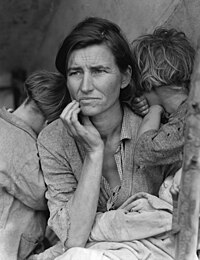The Family of Man

The Family of Man was a photography exhibition curated by Edward Steichen first shown in 1955 at the Museum of Modern Art in New York.
According to Steichen, the exhibition represented the 'culmination of his career'. The 503 photos by 273 photographers in 68 countries were selected from almost 2 million pictures submitted by famous and unknown photographers.[1] These photos offer a striking snapshot of the human experience which lingers on birth, love, and joy, but also touches war, privation, illness and death. His intention was to prove visually the universality of human experience and photography's role in its documentation.
The exhibit was turned into a book of the same name, containing an introduction by Carl Sandburg who was Steichen's brother-in-law. The book was reproduced in a variety of formats (most popularly a pocket-sized volume) in the 1950s, and reprinted in large format for its 40th anniversary. It has sold more than 4 million copies.
The exhibition later travelled in several versions to 38 countries. More than 9 million people viewed the exhibit. The only surviving edition was presented to Luxembourg, the country of Steichen's birth, and is on permanent display in Clervaux.
External links
- official website of the Museum THE FAMILY OF MAN, Clervaux, Luxembourg
- the German art school project (Gymnasium Mechernich)
- CarlSandburg.net: A Research Website for Sandburg Studies
- 50°03′15″N 6°01′49″E / 50.054246°N 6.03025°E[2] Geo-links for The Family of Man
References
- Steichen, Edward (2003) [1955]. The Family of Man. New York: The Museum of Modern Art. ISBN 0-87070-341-2
- Sandeen, Eric J. Picturing An Exhibition: The Family of Man and 1950s America. Albuquerque: University of New Mexico Press, 1995.
